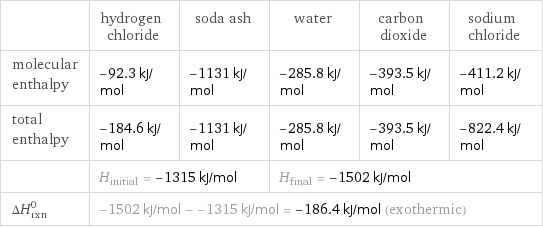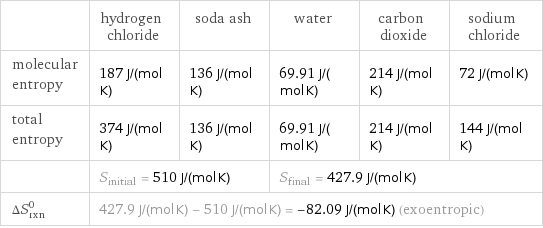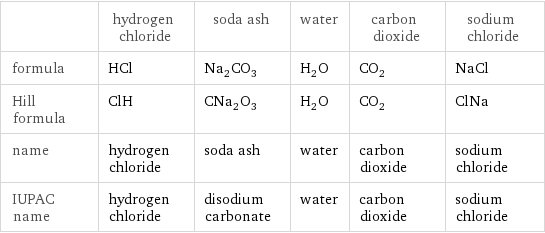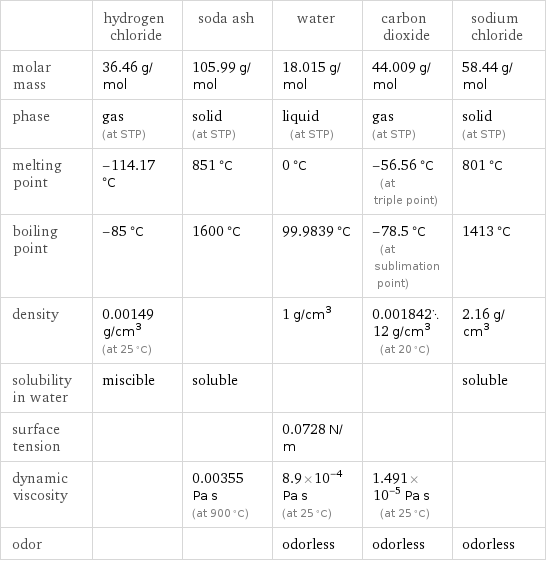Input interpretation

HCl (hydrogen chloride) + Na_2CO_3 (soda ash) ⟶ H_2O (water) + CO_2 (carbon dioxide) + NaCl (sodium chloride)
Balanced equation

Balance the chemical equation algebraically: HCl + Na_2CO_3 ⟶ H_2O + CO_2 + NaCl Add stoichiometric coefficients, c_i, to the reactants and products: c_1 HCl + c_2 Na_2CO_3 ⟶ c_3 H_2O + c_4 CO_2 + c_5 NaCl Set the number of atoms in the reactants equal to the number of atoms in the products for Cl, H, C, Na and O: Cl: | c_1 = c_5 H: | c_1 = 2 c_3 C: | c_2 = c_4 Na: | 2 c_2 = c_5 O: | 3 c_2 = c_3 + 2 c_4 Since the coefficients are relative quantities and underdetermined, choose a coefficient to set arbitrarily. To keep the coefficients small, the arbitrary value is ordinarily one. For instance, set c_2 = 1 and solve the system of equations for the remaining coefficients: c_1 = 2 c_2 = 1 c_3 = 1 c_4 = 1 c_5 = 2 Substitute the coefficients into the chemical reaction to obtain the balanced equation: Answer: | | 2 HCl + Na_2CO_3 ⟶ H_2O + CO_2 + 2 NaCl
Structures

+ ⟶ + +
Names

hydrogen chloride + soda ash ⟶ water + carbon dioxide + sodium chloride
Reaction thermodynamics
Enthalpy

| hydrogen chloride | soda ash | water | carbon dioxide | sodium chloride molecular enthalpy | -92.3 kJ/mol | -1131 kJ/mol | -285.8 kJ/mol | -393.5 kJ/mol | -411.2 kJ/mol total enthalpy | -184.6 kJ/mol | -1131 kJ/mol | -285.8 kJ/mol | -393.5 kJ/mol | -822.4 kJ/mol | H_initial = -1315 kJ/mol | | H_final = -1502 kJ/mol | | ΔH_rxn^0 | -1502 kJ/mol - -1315 kJ/mol = -186.4 kJ/mol (exothermic) | | | |
Gibbs free energy

| hydrogen chloride | soda ash | water | carbon dioxide | sodium chloride molecular free energy | -95.3 kJ/mol | -1044 kJ/mol | -237.1 kJ/mol | -394.4 kJ/mol | -384.1 kJ/mol total free energy | -190.6 kJ/mol | -1044 kJ/mol | -237.1 kJ/mol | -394.4 kJ/mol | -768.2 kJ/mol | G_initial = -1235 kJ/mol | | G_final = -1400 kJ/mol | | ΔG_rxn^0 | -1400 kJ/mol - -1235 kJ/mol = -164.7 kJ/mol (exergonic) | | | |
Entropy

| hydrogen chloride | soda ash | water | carbon dioxide | sodium chloride molecular entropy | 187 J/(mol K) | 136 J/(mol K) | 69.91 J/(mol K) | 214 J/(mol K) | 72 J/(mol K) total entropy | 374 J/(mol K) | 136 J/(mol K) | 69.91 J/(mol K) | 214 J/(mol K) | 144 J/(mol K) | S_initial = 510 J/(mol K) | | S_final = 427.9 J/(mol K) | | ΔS_rxn^0 | 427.9 J/(mol K) - 510 J/(mol K) = -82.09 J/(mol K) (exoentropic) | | | |
Equilibrium constant
![Construct the equilibrium constant, K, expression for: HCl + Na_2CO_3 ⟶ H_2O + CO_2 + NaCl Plan: • Balance the chemical equation. • Determine the stoichiometric numbers. • Assemble the activity expression for each chemical species. • Use the activity expressions to build the equilibrium constant expression. Write the balanced chemical equation: 2 HCl + Na_2CO_3 ⟶ H_2O + CO_2 + 2 NaCl Assign stoichiometric numbers, ν_i, using the stoichiometric coefficients, c_i, from the balanced chemical equation in the following manner: ν_i = -c_i for reactants and ν_i = c_i for products: chemical species | c_i | ν_i HCl | 2 | -2 Na_2CO_3 | 1 | -1 H_2O | 1 | 1 CO_2 | 1 | 1 NaCl | 2 | 2 Assemble the activity expressions accounting for the state of matter and ν_i: chemical species | c_i | ν_i | activity expression HCl | 2 | -2 | ([HCl])^(-2) Na_2CO_3 | 1 | -1 | ([Na2CO3])^(-1) H_2O | 1 | 1 | [H2O] CO_2 | 1 | 1 | [CO2] NaCl | 2 | 2 | ([NaCl])^2 The equilibrium constant symbol in the concentration basis is: K_c Mulitply the activity expressions to arrive at the K_c expression: Answer: | | K_c = ([HCl])^(-2) ([Na2CO3])^(-1) [H2O] [CO2] ([NaCl])^2 = ([H2O] [CO2] ([NaCl])^2)/(([HCl])^2 [Na2CO3])](../image_source/6a4b30d6c6c02b28f69fa9e82937eab8.png)
Construct the equilibrium constant, K, expression for: HCl + Na_2CO_3 ⟶ H_2O + CO_2 + NaCl Plan: • Balance the chemical equation. • Determine the stoichiometric numbers. • Assemble the activity expression for each chemical species. • Use the activity expressions to build the equilibrium constant expression. Write the balanced chemical equation: 2 HCl + Na_2CO_3 ⟶ H_2O + CO_2 + 2 NaCl Assign stoichiometric numbers, ν_i, using the stoichiometric coefficients, c_i, from the balanced chemical equation in the following manner: ν_i = -c_i for reactants and ν_i = c_i for products: chemical species | c_i | ν_i HCl | 2 | -2 Na_2CO_3 | 1 | -1 H_2O | 1 | 1 CO_2 | 1 | 1 NaCl | 2 | 2 Assemble the activity expressions accounting for the state of matter and ν_i: chemical species | c_i | ν_i | activity expression HCl | 2 | -2 | ([HCl])^(-2) Na_2CO_3 | 1 | -1 | ([Na2CO3])^(-1) H_2O | 1 | 1 | [H2O] CO_2 | 1 | 1 | [CO2] NaCl | 2 | 2 | ([NaCl])^2 The equilibrium constant symbol in the concentration basis is: K_c Mulitply the activity expressions to arrive at the K_c expression: Answer: | | K_c = ([HCl])^(-2) ([Na2CO3])^(-1) [H2O] [CO2] ([NaCl])^2 = ([H2O] [CO2] ([NaCl])^2)/(([HCl])^2 [Na2CO3])
Rate of reaction
![Construct the rate of reaction expression for: HCl + Na_2CO_3 ⟶ H_2O + CO_2 + NaCl Plan: • Balance the chemical equation. • Determine the stoichiometric numbers. • Assemble the rate term for each chemical species. • Write the rate of reaction expression. Write the balanced chemical equation: 2 HCl + Na_2CO_3 ⟶ H_2O + CO_2 + 2 NaCl Assign stoichiometric numbers, ν_i, using the stoichiometric coefficients, c_i, from the balanced chemical equation in the following manner: ν_i = -c_i for reactants and ν_i = c_i for products: chemical species | c_i | ν_i HCl | 2 | -2 Na_2CO_3 | 1 | -1 H_2O | 1 | 1 CO_2 | 1 | 1 NaCl | 2 | 2 The rate term for each chemical species, B_i, is 1/ν_i(Δ[B_i])/(Δt) where [B_i] is the amount concentration and t is time: chemical species | c_i | ν_i | rate term HCl | 2 | -2 | -1/2 (Δ[HCl])/(Δt) Na_2CO_3 | 1 | -1 | -(Δ[Na2CO3])/(Δt) H_2O | 1 | 1 | (Δ[H2O])/(Δt) CO_2 | 1 | 1 | (Δ[CO2])/(Δt) NaCl | 2 | 2 | 1/2 (Δ[NaCl])/(Δt) (for infinitesimal rate of change, replace Δ with d) Set the rate terms equal to each other to arrive at the rate expression: Answer: | | rate = -1/2 (Δ[HCl])/(Δt) = -(Δ[Na2CO3])/(Δt) = (Δ[H2O])/(Δt) = (Δ[CO2])/(Δt) = 1/2 (Δ[NaCl])/(Δt) (assuming constant volume and no accumulation of intermediates or side products)](../image_source/165892c9438dede05c1f1c6a2bd5cc79.png)
Construct the rate of reaction expression for: HCl + Na_2CO_3 ⟶ H_2O + CO_2 + NaCl Plan: • Balance the chemical equation. • Determine the stoichiometric numbers. • Assemble the rate term for each chemical species. • Write the rate of reaction expression. Write the balanced chemical equation: 2 HCl + Na_2CO_3 ⟶ H_2O + CO_2 + 2 NaCl Assign stoichiometric numbers, ν_i, using the stoichiometric coefficients, c_i, from the balanced chemical equation in the following manner: ν_i = -c_i for reactants and ν_i = c_i for products: chemical species | c_i | ν_i HCl | 2 | -2 Na_2CO_3 | 1 | -1 H_2O | 1 | 1 CO_2 | 1 | 1 NaCl | 2 | 2 The rate term for each chemical species, B_i, is 1/ν_i(Δ[B_i])/(Δt) where [B_i] is the amount concentration and t is time: chemical species | c_i | ν_i | rate term HCl | 2 | -2 | -1/2 (Δ[HCl])/(Δt) Na_2CO_3 | 1 | -1 | -(Δ[Na2CO3])/(Δt) H_2O | 1 | 1 | (Δ[H2O])/(Δt) CO_2 | 1 | 1 | (Δ[CO2])/(Δt) NaCl | 2 | 2 | 1/2 (Δ[NaCl])/(Δt) (for infinitesimal rate of change, replace Δ with d) Set the rate terms equal to each other to arrive at the rate expression: Answer: | | rate = -1/2 (Δ[HCl])/(Δt) = -(Δ[Na2CO3])/(Δt) = (Δ[H2O])/(Δt) = (Δ[CO2])/(Δt) = 1/2 (Δ[NaCl])/(Δt) (assuming constant volume and no accumulation of intermediates or side products)
Chemical names and formulas

| hydrogen chloride | soda ash | water | carbon dioxide | sodium chloride formula | HCl | Na_2CO_3 | H_2O | CO_2 | NaCl Hill formula | ClH | CNa_2O_3 | H_2O | CO_2 | ClNa name | hydrogen chloride | soda ash | water | carbon dioxide | sodium chloride IUPAC name | hydrogen chloride | disodium carbonate | water | carbon dioxide | sodium chloride
Substance properties

| hydrogen chloride | soda ash | water | carbon dioxide | sodium chloride molar mass | 36.46 g/mol | 105.99 g/mol | 18.015 g/mol | 44.009 g/mol | 58.44 g/mol phase | gas (at STP) | solid (at STP) | liquid (at STP) | gas (at STP) | solid (at STP) melting point | -114.17 °C | 851 °C | 0 °C | -56.56 °C (at triple point) | 801 °C boiling point | -85 °C | 1600 °C | 99.9839 °C | -78.5 °C (at sublimation point) | 1413 °C density | 0.00149 g/cm^3 (at 25 °C) | | 1 g/cm^3 | 0.00184212 g/cm^3 (at 20 °C) | 2.16 g/cm^3 solubility in water | miscible | soluble | | | soluble surface tension | | | 0.0728 N/m | | dynamic viscosity | | 0.00355 Pa s (at 900 °C) | 8.9×10^-4 Pa s (at 25 °C) | 1.491×10^-5 Pa s (at 25 °C) | odor | | | odorless | odorless | odorless
Units
